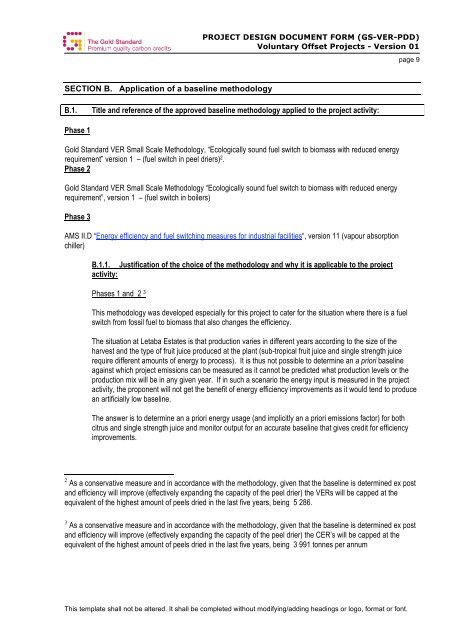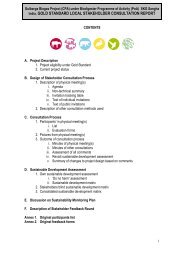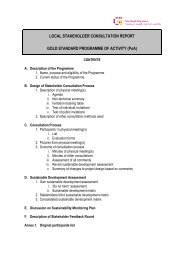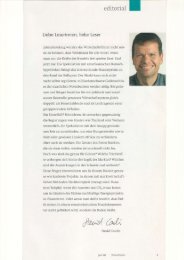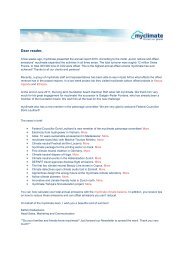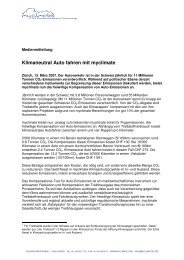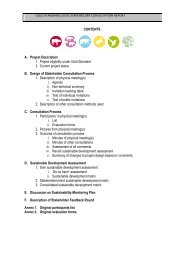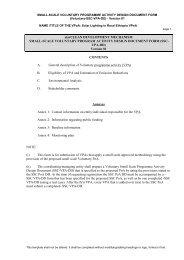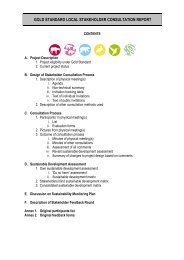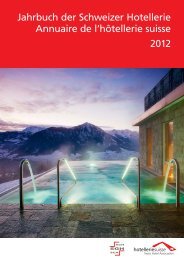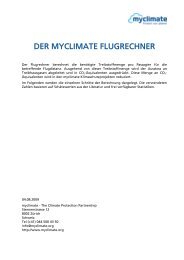Letaba Biomass to Energy PDD - MyClimate
Letaba Biomass to Energy PDD - MyClimate
Letaba Biomass to Energy PDD - MyClimate
You also want an ePaper? Increase the reach of your titles
YUMPU automatically turns print PDFs into web optimized ePapers that Google loves.
SECTION B. Application of a baseline methodology<br />
PROJECT DESIGN DOCUMENT FORM (GS-VER-<strong>PDD</strong>)<br />
Voluntary Offset Projects - Version 01<br />
B.1. Title and reference of the approved baseline methodology applied <strong>to</strong> the project activity:<br />
Phase 1<br />
Gold Standard VER Small Scale Methodology, “Ecologically sound fuel switch <strong>to</strong> biomass with reduced energy<br />
requirement” version 1 – (fuel switch in peel driers) 2 .<br />
Phase 2<br />
Gold Standard VER Small Scale Methodology “Ecologically sound fuel switch <strong>to</strong> biomass with reduced energy<br />
requirement”, version 1 – (fuel switch in boilers)<br />
Phase 3<br />
AMS II.D “<strong>Energy</strong> efficiency and fuel switching measures for industrial facilities“, version 11 (vapour absorption<br />
chiller)<br />
B.1.1. Justification of the choice of the methodology and why it is applicable <strong>to</strong> the project<br />
activity:<br />
Phases 1 and 2 3<br />
This methodology was developed especially for this project <strong>to</strong> cater for the situation where there is a fuel<br />
switch from fossil fuel <strong>to</strong> biomass that also changes the efficiency.<br />
This template shall not be altered. It shall be completed without modifying/adding headings or logo, format or font.<br />
page 9<br />
The situation at <strong>Letaba</strong> Estates is that production varies in different years according <strong>to</strong> the size of the<br />
harvest and the type of fruit juice produced at the plant (sub-tropical fruit juice and single strength juice<br />
require different amounts of energy <strong>to</strong> process). It is thus not possible <strong>to</strong> determine an a priori baseline<br />
against which project emissions can be measured as it cannot be predicted what production levels or the<br />
production mix will be in any given year. If in such a scenario the energy input is measured in the project<br />
activity, the proponent will not get the benefit of energy efficiency improvements as it would tend <strong>to</strong> produce<br />
an artificially low baseline.<br />
The answer is <strong>to</strong> determine an a priori energy usage (and implicitly an a priori emissions fac<strong>to</strong>r) for both<br />
citrus and single strength juice and moni<strong>to</strong>r output for an accurate baseline that gives credit for efficiency<br />
improvements.<br />
2 As a conservative measure and in accordance with the methodology, given that the baseline is determined ex post<br />
and efficiency will improve (effectively expanding the capacity of the peel drier) the VERs will be capped at the<br />
equivalent of the highest amount of peels dried in the last five years, being 5 286.<br />
3 As a conservative measure and in accordance with the methodology, given that the baseline is determined ex post<br />
and efficiency will improve (effectively expanding the capacity of the peel drier) the CER’s will be capped at the<br />
equivalent of the highest amount of peels dried in the last five years, being 3 991 <strong>to</strong>nnes per annum


